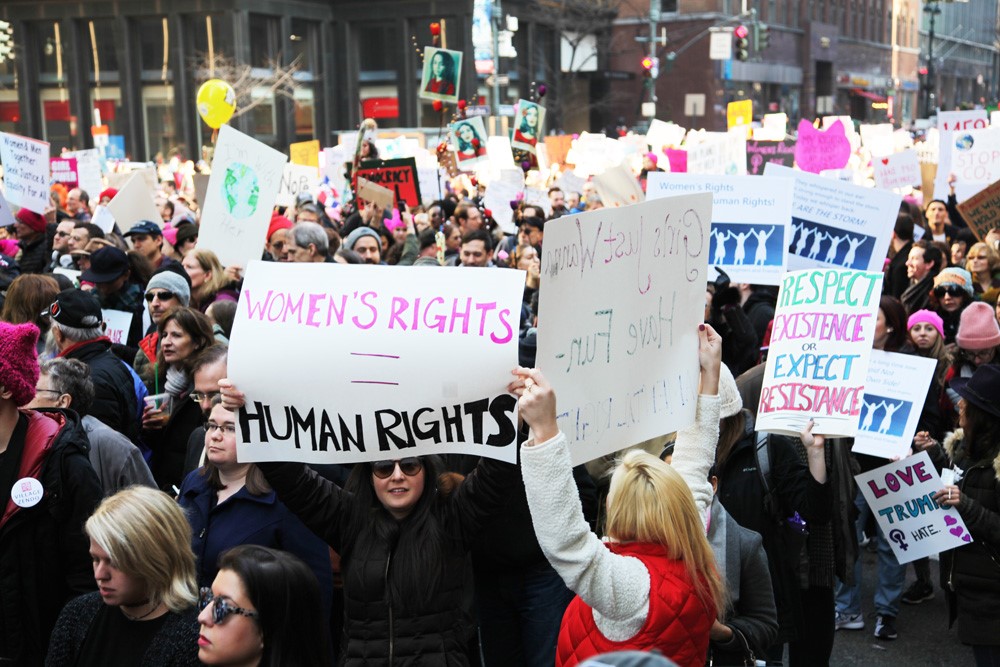
Women have been protesting in the streets with signs that say, “My body, my choice,” “Women’s rights are human rights,” “I am a woman not a womb” and “Want fewer abortions? Support Planned Parenthood.” More women are growing concerned about their reproductive rights since Donald J. Trump was elected president in November. Planned Parenthood reported that since Trump was elected, they had a 900 percent increase in women seeking intrauterine devices (IUDs), which is a birth control that can last up to 12 years and outlast a Trump presidency. Although Trump was not in office at the time, women were afraid that their options for birth control would be scarce under a Trump administration. Some women see the Trump administration as a majority of congress who want to defund Planned Parenthood and a vice president who continues to be an advocate for an anti-abortion laws. These women’s fears are also due to Trump’s stance on abortion when he was on the campaign trail.
During the campaign trail in February of 2016, Trump said that Planned Parenthood “helps million and millions of women” who need breast and cervical-cancer screenings. Despite this, he said that he would still defund Planned Parenthood because the organization provides abortion services at some of their locations. According to Planned Parenthood, only three percent of their services were abortions in 2016. Then in March of 2016, Trump told MSNBC’s Chris Matthews that women who have abortions should be punished legally, but Trump quickly changed his claim after he received lots of backlash.
Not too long after Trump was inaugurated, Trump’s stance on abortion started to become clearer. Three days after President’s inauguration, Trump signed an executive order that reinstated the Mexico City Policy or also known as the Global Gag Rule. According to the Kaiser Family Foundation, a non-profit organization that informs the public on national health issues, the policy requires that foreign non-governmental organizations to not use any source of money to “preform or actively promote abortion as a method of family planning,” so that they may receive U.S. family planning assistance or U.S. global health assistance. This policy was first announced in 1984 by the Reagan administration and has been in effect for about 17 years out of the 32 years it has existed.

Currently, the most recent advances in the plan to repeal and replace Obamacare have not made women feel any less uneasy about their reproductive rights. Under Obamacare, there are provisions that require insurers to cover IUDs and other contraception. Under the new bill, reproductive rights and Planned Parenthood are definitely at risk, but it seems all rather unclear.
What is clear is that the proposed plan defunds Planned Parenthood for one year, with no provision to refund. With the majority of Congress being republican, most are unsure if Planned Parenthood will ever be refunded in that case. Although, Moderate republican senators Susan Collins (R–ME) and Lisa Murkowski (R–AK) have already said they will not pass any version of a healthcare bill that defunds Planned Parenthood.
What is unclear is the coverage of reproductive rights. It is all due to what the bill considers to be pre-existing conditions. According to AP Health writer, Tom Murphy, pregnancy, sexual assault and domestic violence could be considered pre-existing conditions. Although the bill does not explicitly refer to any of these things, the bill does allow insurers to charge more for a health condition that existed before the patient’s coverage starts.
Murphy states that there is potential for rape victims to not have post-rape therapy covered under the bill’s logic. Many of those on social media have taken this potential as definite, when the plan does not explicitly mention rape victims.
According to the Kaiser Family Foundation, Obamacare allows states to ban any insurance plan from covering abortion. Currently, 25 states have laws that ban or limit coverage of abortion for some insurance plans. The proposed healthcare plan would not make this a state option any longer. Instead, the plan would ensure no federal dollars are used to subsidize abortion coverage. This means that most plans, including those enrolled in private insurance, would not cover abortion. This plan for abortion is in direct conflict with existing policies in New York and California that require plans to cover abortion. Therefore, the new bill would have to face legal challenges on the matter of abortion coverage.
On May 4th, the House of Representatives passed the proposal of the new healthcare plan. Two hundred-eighteen republican representatives voted to approve the bill and all democrats and 20 republicans voted to oppose it. The total vote was 218 to 217. The next step for the bill is to be voted on at the Senate. Tom Price, Health and Human Services Secretary predicts that the Senate will vote on the bill before August.
The reaction to this passing has not been approved by most of those who support reproductive rights. Nancy Northup, President and CEO of the Center for Reproductive Rights, said in a statement that, “Trump’s plan is dangerous for women’s health and our ability to make decisions about our futures and our families. From gutting maternity coverage to blocking women from getting health care at Planned Parenthood to eliminating guaranteed coverage for those with pre-existing conditions, the measure passed today will drive health care out of reach for millions.”
Others who support of reproductive rights continue to be heard through their protests, social media posts, and talks with their congresspersons. The common logic that all of these supporters possess is that birth control is a personal choice, not a political one.


